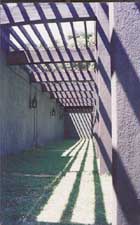|

What June brides are wearing

Model: Nadeera
Bouquet and Tiara: Lucien de Silva |

Model: Dilrukshi
Bouquet and headdress: Mary Jayeratne
|
| All brides hair, make-up and dressing by Ramani,
Cheryl, Johann, Dihara and Ruwani of Ramani Fernando Salons. Photographs:
Mettasena, Photo Location: Colombo Hilton |
The course of acne therapy
Acne is a complex disease and, as with many other
diseases, the degree of control possible varies. In many cases complete
remissions can be obtained; in others only partial control is possible.
However it is not necessary to let acne make your life miserable and it
need not be feared as something that is untreatable. Most cases can be
controlled minimizing the severity and resulting scarring. Left untreated,
it can result in permanent scarring and affect your self-image.
The course of acne therapy will vary according to such factors as the
type and severity of the case and the patient's age. An individual approach
to care and therapy is important in many instances.
Mild cases of acne may respond to the various therapeutic agents you
can purchase in a drugstore. These include various special cleansers and
topical preparations. They usually contain benzoyl peroxide sulphur resorcin
or salicylic acid. Others are abrasives.
If you use one of these products be sure to read and carefully follow
the manufacturers directions for use. If your skin becomes too dry or irritated
use the product less often, or stop using it altogether.
If your acne does not respond to these self-treatment products, you
should seek medical treatment from a dermatologist who will tailor treatment
to your specific needs and will most likely prescribe a combination of
treatments.
The dermatologist will probably prescribe a variety of topical and oral
agents. The most commonly used oral agents are antibiotics. While the dermatologist
may remove the closed and open comedones, he or she will most certainly
warn you against removing the lesions yourself.
This is important because the cells of the follicular wall prevent the
contents of the follicle from spilling into the skin and causing inflammation.
When you remove the lesions improperly—for example, by squeezing—these
natural barriers may be broken down and more inflammation and scarring
may result.
When multiple cysts are present, your dermatologist may inject a corticosteroid
preparation into the lesions or drain them.
You must work closely with your dermatologist and follow the recommended
treatment regimens.
Ask questions if you don't understand some aspect of the treatment program.
Together you will be able to control your acne so your life does not have
to be miserable.
Givenchy's exciting new fragrance
Parfums Givenchy, Paris together with The Parfumerie
at Majestic City and Liberty Plaza, will launch Givenchy's exciting new
fragrance Extravagance d' Amarige in Colombo, this week.
This new fragrance is planned to revitalize and rejuvenate Amarige,
one of Givenchy's most successful fragrances.
Both Amarige and Extravagance have been modelled by supermodel Eva Herzigova.
Amarige reflects the sophisticated, refined and the beautiful while
Extravagance is provocative, sexy, mischievous and somewhat naughty.
Extravagance d' Amarige will be launched in Sri Lanka during the visit
of Christine Escoffier, Parfums Givenchy's International Beauty Consultant
and Manager Training during the 2nd week of June.
Know your sunglasses
Your guide to sunglasses — whether
you buy them as fashion accessories or as protection against the glare.
Just as sunlight can dam age your skin by causing
sunburn, premature ageing and skin cancer, it is also harmful for your
eyes. Over exposure to sunlight can damage your eyes, resulting in early
cataracts or damage to the retina. You should, therefore, protect your
eyes whenever you are in the sun long enough to get a suntan or sunburn.
Wearing a hat with a brim can cut your exposure by half, but the best way
is to wear sunglasses which block the ultraviolet rays of the sun.
The light factor
There are two types of ultraviolet (UV) rays which reach
the earth — UV-A and UV-B. UV-B rays pose a problem in deserts and at altitudes,
especially in snow, causing 'snow blindness', a temporary but painful condition.
Prolonged exposure to UV-A may lead to premature cataract formations. Next,
consider blue light, the light at the end of the visible spectrum.
Prolonged exposure to blue light may damage your retina, more so if you
stare at the sun with naked eyes. Infrared light too can damage
your eyes permanently if you stare at the sun unprotected. Even if you
are wearing sunglasses, never look directly at the sun. However, the low
levels of infrared rays present in daylight are now considered harmless
to the eye. Some people suffer from eye conditions which cause an intolerance
to light. They need to wear light tinted glasses most of the time and glasses
with a darker tint in the sun. They should consult an ophthalmologist for
advice.
Do You Need Sunglasses?
For people with normal healthy eyes, the answer is probably 'no',
since you should be able to cope with short periods of sunshine without
sunglasses. But if you stay out in bright sunlight for longer periods,
or you're going where the light is reflected off, say, white buildings
or snow, sunglasses can reduce the glare, making your eyes feel more comfortable.
However, you really need to protect your eyes from possible damage while
mountaineering or skiing, or travelling in desert conditions, or if you
live somewhere where you're regularly exposed to sunshine. In these situations,
the risk to your eyes is due to the increased exposure to ultraviolet (UV)
and blue light.
Making the chioce
Price is no certain indicator of quality, so how does one choose?
Here are some factors to help you make the decision:
Colour
The colour of a lens is unrelated to its ability to protect your
eyes against ultraviolet rays. The colours that distort your vision the
least — dark grey or green tints — are the best. A medium dark lens is
good for day-to-day wear. Choose a darker shade if you plan to use the
glasses in very bright conditions.
Distortion
To judge the quality of non-prescription sunglasses, hold them
a few centimetres in front of your eyes and look through them at something
with a rectangular pattern, such as a floor tile. Move the glass slowly
from side to side, then up and down. If the lines wiggle, especially in
the centre of the lens, try another pair.
Lenses
There are various types of lenses in the market to choose from:
Ordinary
* Glass: Fine for general use, but not as safe as plastic for rough
wear.
* Plain plastic: Lighter and less likely to break than glass.
A good choice, provided it is coated.
* Scratch-resistant plastic: A good choice. Lighter and stronger
than glass, and better than plain plastic, because it is less likely to
get scratched.
* Polarised plastic: Good for activities such as fishing or sailing,
as it cuts the reflected glare on smooth surfaces, such as roads and water.
* Polycarbonate: The strongest of them all, but scratches easily
unless coated. Worth considering if you want good eye protection for driving
or playing outdoors.
Tints and Special Effects
* Gradient: Available in glass or plastic. The most common are
dark on top, gradually clearing towards the bottom. Okay for driving or
reading outdoors — but not on the beach or ski slopes.
* Mirror lenses: Glass lenses with one surface mirrored so the
eyes are hidden from view. Popular as a fashion. accessory, and to protect
from glare in skiing and water sports. Avoid for normal use, though they
are useful for hiding any eye disfigurement.
* Photochromatic: Available in glass or plastic. Lighter when
indoors or in cloudy weather, but darken — in about 30 seconds — in sunlight.
Glass lenses darken and clear quicker than plastic. Good for spectacle
wearers since it requires no change from the normal prescription pair.
A good choice, but go for the glass.
Comfort
Be sure to buy a comfortable pair of sunglasses that you can wear
over a length of time — otherwise, their light-shielding abilities will
be irrelevant.
|
Remember
• You must wear sunglasses if you spend lots of time in the sunlight.
• The eyes of people below 30 do not have sufficient pigmentation to
prevent transmission of the harmful rays. Therefore, children and youngsters
should use sunglasses, especially where the reflection is high.
• If your eyes have been operated on for cataract, UV-absorbing sunglasses
are essential.
• Well-known brands usually indicate what percentage of the UV rays
the lenses block. Select the glasses which offer the maximum protection.
• If you wear contact lenses, always use sunglasses in the sun. The
eyes of a constant contact lens user are more sensitive to sunlight and
need to be protected from dust and wind.
• Many people wear sunglasses to avoid oncoming headlight glare while
driving at night. This can affect vision. One should also not use sunglasses
in poor visibility conditions, unless advised clinically.
|
Unusual vistas of the Kandalama Hotel
Mirror photographer Mettasena
captured these Unusual vistas of the Kandalama Hotel, which though built
amidst a storm of controversy some years ago has succeeded in maintaining
its 'green' outlook.
|






![]()



